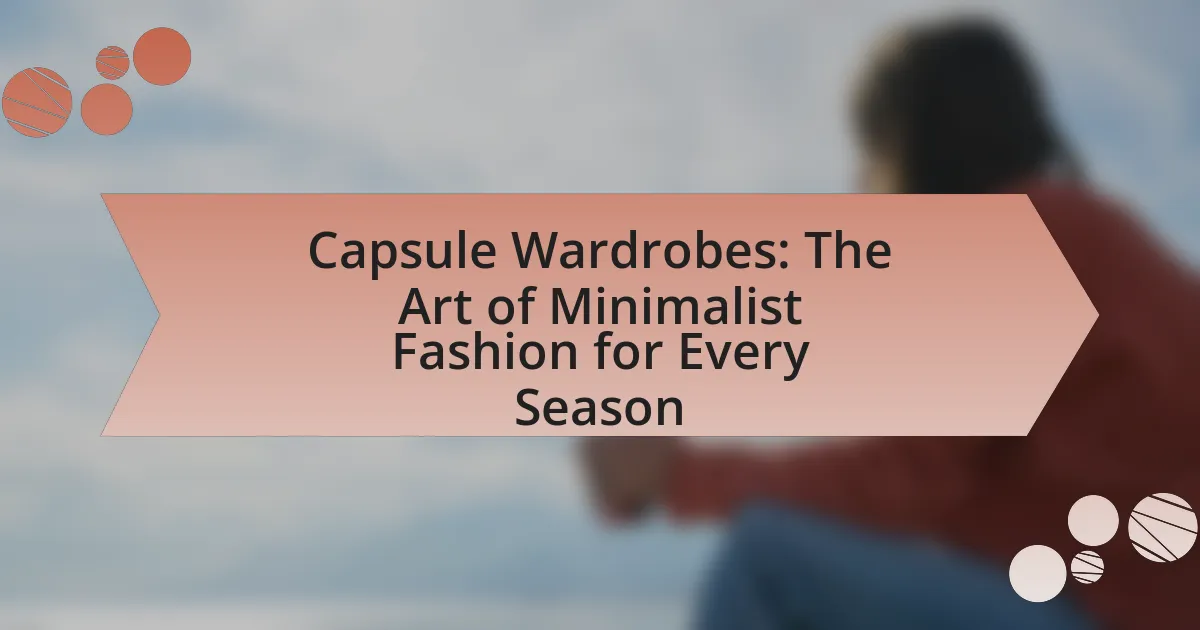Capsule wardrobes are curated collections of essential clothing items, typically consisting of 30 to 40 versatile pieces that can be mixed and matched to create various outfits. This minimalist approach, which emphasizes quality over quantity, promotes sustainable fashion by reducing clutter and encouraging mindful consumption. The article explores the principles of capsule wardrobes, their environmental benefits, and practical steps for creating seasonal wardrobes. It also addresses common challenges in maintaining a capsule wardrobe and offers strategies for overcoming wardrobe fatigue while enhancing personal style and budget efficiency.

What is a Capsule Wardrobe?
A capsule wardrobe is a collection of essential clothing items that can be mixed and matched to create a variety of outfits. This concept promotes minimalism by focusing on quality over quantity, typically consisting of around 30 to 40 pieces, including tops, bottoms, outerwear, and shoes. The idea originated in the 1970s, popularized by designer Susie Faux, and has gained traction as a sustainable fashion choice, reducing clutter and encouraging mindful consumption.
How does a Capsule Wardrobe differ from a traditional wardrobe?
A capsule wardrobe differs from a traditional wardrobe primarily in its size and focus on versatility. A capsule wardrobe typically consists of a limited number of essential, high-quality pieces that can be mixed and matched to create various outfits, often ranging from 20 to 40 items. In contrast, a traditional wardrobe usually contains a larger collection of clothing, often including many items that may not be frequently worn. This streamlined approach in a capsule wardrobe promotes minimalism and intentionality in fashion choices, reducing decision fatigue and clutter.
What are the key principles of a Capsule Wardrobe?
The key principles of a Capsule Wardrobe include minimalism, versatility, and intentionality. Minimalism focuses on reducing the number of clothing items to essential pieces, typically around 30 to 40 items, which simplifies decision-making and promotes a clutter-free lifestyle. Versatility ensures that each piece can be mixed and matched to create multiple outfits, maximizing the utility of each item. Intentionality involves selecting clothing that aligns with personal style, lifestyle needs, and seasonal appropriateness, ensuring that every piece serves a purpose and contributes to a cohesive wardrobe. These principles collectively foster a sustainable approach to fashion, reducing waste and encouraging mindful consumption.
How many pieces should be included in a Capsule Wardrobe?
A capsule wardrobe should typically include 30 to 40 pieces. This range allows for a versatile selection of clothing that can be mixed and matched to create various outfits while maintaining a minimalist approach. The concept of a capsule wardrobe emphasizes quality over quantity, enabling individuals to curate a collection that reflects their personal style and meets their daily needs.
Why is Minimalist Fashion important in today’s world?
Minimalist fashion is important in today’s world because it promotes sustainability and reduces consumerism. By focusing on quality over quantity, minimalist fashion encourages individuals to invest in versatile, timeless pieces that can be worn in multiple ways, thereby minimizing waste. According to a 2021 report by the Ellen MacArthur Foundation, the fashion industry is responsible for 10% of global carbon emissions, highlighting the need for more sustainable practices. Embracing minimalist fashion can significantly lower one’s environmental footprint while fostering a more intentional approach to personal style.
What are the environmental benefits of adopting a Capsule Wardrobe?
Adopting a Capsule Wardrobe significantly reduces environmental impact by minimizing clothing consumption and waste. This approach encourages individuals to purchase fewer, higher-quality garments, which leads to less textile waste in landfills; in fact, the fashion industry contributes to 92 million tons of waste annually. Additionally, a Capsule Wardrobe promotes sustainable practices by reducing the demand for fast fashion, which is responsible for high levels of pollution and resource depletion, including the use of 2,700 liters of water to produce a single cotton t-shirt. By focusing on versatile pieces, consumers can extend the lifecycle of their clothing, further decreasing the environmental footprint associated with production and disposal.
How does Minimalist Fashion contribute to personal style and identity?
Minimalist fashion contributes to personal style and identity by emphasizing simplicity and intentionality in clothing choices. This approach allows individuals to curate a wardrobe that reflects their values and aesthetic preferences, fostering a sense of authenticity. Research indicates that minimalist fashion promotes self-expression by encouraging individuals to focus on quality over quantity, leading to a more cohesive and personalized style. For instance, a study published in the Journal of Fashion Marketing and Management highlights that consumers who adopt minimalist principles often report increased satisfaction with their clothing choices, as they feel their outfits better represent their true selves.

How can you create a Capsule Wardrobe for each season?
To create a Capsule Wardrobe for each season, start by selecting a limited number of versatile clothing pieces that can be mixed and matched. For spring, include lightweight layers like cardigans, breathable tops, and versatile bottoms such as chinos or skirts. In summer, focus on breathable fabrics, incorporating items like sundresses, shorts, and tank tops. For fall, add layers such as sweaters, long-sleeve shirts, and transitional outerwear like denim jackets. In winter, prioritize warmth with items like coats, thermal tops, and heavier pants.
Research indicates that a typical capsule wardrobe consists of 30 to 40 pieces per season, allowing for a functional yet stylish collection that minimizes decision fatigue and maximizes outfit combinations. This approach not only simplifies dressing but also promotes sustainable fashion practices by reducing overconsumption.
What steps should you follow to build a seasonal Capsule Wardrobe?
To build a seasonal Capsule Wardrobe, start by defining your personal style and identifying key pieces that reflect it. Next, assess your current wardrobe to determine which items you wear frequently and which can be eliminated. After that, select versatile clothing items that can be mixed and matched, focusing on a cohesive color palette. Limit the number of pieces to around 30-40 items for the season, including tops, bottoms, outerwear, and accessories. Finally, review and adjust your selections at the end of the season to prepare for the next, ensuring that your Capsule Wardrobe remains functional and aligned with your evolving style.
How do you select versatile pieces for different seasons?
To select versatile pieces for different seasons, prioritize items that can be layered and styled in multiple ways. Versatile pieces should be made from adaptable fabrics, such as cotton or wool, which provide comfort across varying temperatures. For example, a lightweight cardigan can be worn over a summer dress or layered under a winter coat, demonstrating its functionality in both warm and cold weather. Additionally, neutral colors enhance versatility, allowing for easy mixing and matching with other wardrobe items. Research indicates that a well-curated capsule wardrobe, consisting of around 30 essential pieces, can effectively meet seasonal needs while minimizing clutter, as noted in “The Capsule Wardrobe: 1,000 Outfits from 30 Pieces” by Wendy Mak.
What role do colors and patterns play in a seasonal Capsule Wardrobe?
Colors and patterns are essential in a seasonal Capsule Wardrobe as they establish a cohesive aesthetic and enhance versatility. A well-chosen color palette allows for easy mixing and matching of garments, maximizing outfit combinations while minimizing the number of pieces needed. For instance, neutral colors serve as a foundation, while seasonal hues can add freshness and vibrancy. Patterns, when used strategically, can add visual interest and personality without overwhelming the overall look. Research indicates that a limited color scheme can lead to a more efficient dressing process, as it simplifies decision-making and promotes a streamlined wardrobe.
How do you transition your Capsule Wardrobe between seasons?
To transition your Capsule Wardrobe between seasons, start by evaluating your current pieces and removing items that no longer fit or are out of season. This process involves assessing the weather and identifying which clothing items can be layered or swapped out. For example, lightweight fabrics can be stored away as heavier materials like wool and denim are introduced for colder months. Additionally, incorporating seasonal colors and patterns can refresh the wardrobe, ensuring it remains stylish and functional. This method not only maintains a cohesive look but also maximizes the utility of each piece throughout the year.
What are the best practices for storing off-season clothing?
The best practices for storing off-season clothing include cleaning items before storage, using breathable containers, and maintaining a cool, dry environment. Cleaning clothing prevents stains from setting and eliminates odors, which is essential for preserving fabric integrity. Breathable containers, such as cotton bags or plastic bins with ventilation, protect garments from moisture and pests, while a cool, dry environment minimizes the risk of mold and mildew. According to the American Cleaning Institute, proper storage techniques can extend the life of clothing by preventing damage from environmental factors.
How can you refresh your Capsule Wardrobe for the new season?
To refresh your Capsule Wardrobe for the new season, start by evaluating your current pieces and removing items that no longer fit or align with your style. This process allows you to identify gaps in your wardrobe that can be filled with seasonal essentials. Next, incorporate a few key trend pieces that complement your existing items, ensuring they can be mixed and matched easily. Research indicates that a well-curated Capsule Wardrobe can reduce decision fatigue and enhance personal style, making it easier to adapt to seasonal changes.

What are the common challenges in maintaining a Capsule Wardrobe?
Common challenges in maintaining a Capsule Wardrobe include limited variety, difficulty in seasonal transitions, and the temptation to acquire new items. Limited variety can lead to outfit fatigue, as the reduced number of pieces may not provide enough options for personal expression. Seasonal transitions pose a challenge because the wardrobe must adapt to changing weather while still adhering to the minimalist principle. Additionally, the temptation to acquire new items can disrupt the curated nature of a Capsule Wardrobe, making it difficult to stick to the original selection and philosophy.
How can you overcome the temptation to buy more clothes?
To overcome the temptation to buy more clothes, individuals can adopt a capsule wardrobe approach, which emphasizes quality over quantity. This method encourages selecting a limited number of versatile, high-quality pieces that can be mixed and matched, reducing the desire for additional clothing. Research indicates that consumers who focus on a minimalist wardrobe experience less decision fatigue and greater satisfaction with their clothing choices, leading to fewer impulsive purchases. By committing to a defined number of items, such as 30 pieces per season, individuals can effectively curb unnecessary spending while maintaining a stylish and functional wardrobe.
What strategies can help you stick to your Capsule Wardrobe plan?
To stick to your Capsule Wardrobe plan, establish clear guidelines for selecting versatile pieces that align with your personal style and lifestyle needs. This involves curating a limited number of high-quality, interchangeable items that can be mixed and matched, which simplifies decision-making and reduces clutter. Research indicates that a well-defined capsule wardrobe can lead to increased satisfaction with clothing choices and decreased shopping frequency, as it encourages mindful consumption and prioritizes quality over quantity.
How do you handle wardrobe fatigue or boredom?
To handle wardrobe fatigue or boredom, one can refresh their style by rotating pieces in a capsule wardrobe. This method involves selecting a limited number of versatile clothing items that can be mixed and matched, which reduces decision fatigue and enhances creativity in outfit selection. Research indicates that a capsule wardrobe can lead to increased satisfaction with clothing choices, as it simplifies the process and encourages intentional dressing. By regularly updating or swapping out a few key items each season, individuals can maintain interest in their wardrobe while still adhering to minimalist principles.
What are the benefits of a Capsule Wardrobe for your lifestyle?
A capsule wardrobe offers several benefits for your lifestyle, including simplicity, cost-effectiveness, and enhanced personal style. By reducing the number of clothing items to essential pieces, individuals can streamline their daily decision-making process, saving time and mental energy. Research indicates that a simplified wardrobe can lead to decreased stress and increased satisfaction with clothing choices. Additionally, investing in high-quality, versatile pieces can reduce overall spending on fashion, as fewer items are needed over time. This approach not only promotes sustainability by minimizing waste but also encourages individuals to develop a clearer sense of personal style, as they focus on what truly resonates with them.
How does a Capsule Wardrobe simplify daily outfit choices?
A capsule wardrobe simplifies daily outfit choices by providing a limited selection of versatile clothing items that can be mixed and matched easily. This curated collection reduces decision fatigue, as individuals can quickly select outfits without sifting through excessive options. Research indicates that limiting choices can enhance satisfaction and efficiency in decision-making, supporting the effectiveness of a capsule wardrobe in streamlining daily dressing routines.
What impact does a Capsule Wardrobe have on your budget?
A Capsule Wardrobe positively impacts your budget by reducing overall clothing expenses. By focusing on a limited selection of versatile, high-quality pieces, individuals tend to spend less on fast fashion and impulse purchases. Research indicates that consumers can save up to 50% on clothing costs by adopting a minimalist approach, as they prioritize essential items over quantity. This strategic investment in fewer, timeless pieces leads to long-term savings and a more sustainable wardrobe.
What practical tips can help you succeed with a Capsule Wardrobe?
To succeed with a Capsule Wardrobe, focus on selecting versatile pieces that can be mixed and matched easily. Start by choosing a limited number of high-quality, timeless items that reflect your personal style and can be worn in various combinations for different occasions. Research indicates that a well-curated Capsule Wardrobe typically consists of 30 to 40 pieces, which allows for a functional yet stylish collection. Additionally, regularly assess and rotate your wardrobe to keep it fresh and aligned with seasonal trends, ensuring that you maintain a cohesive look throughout the year.
